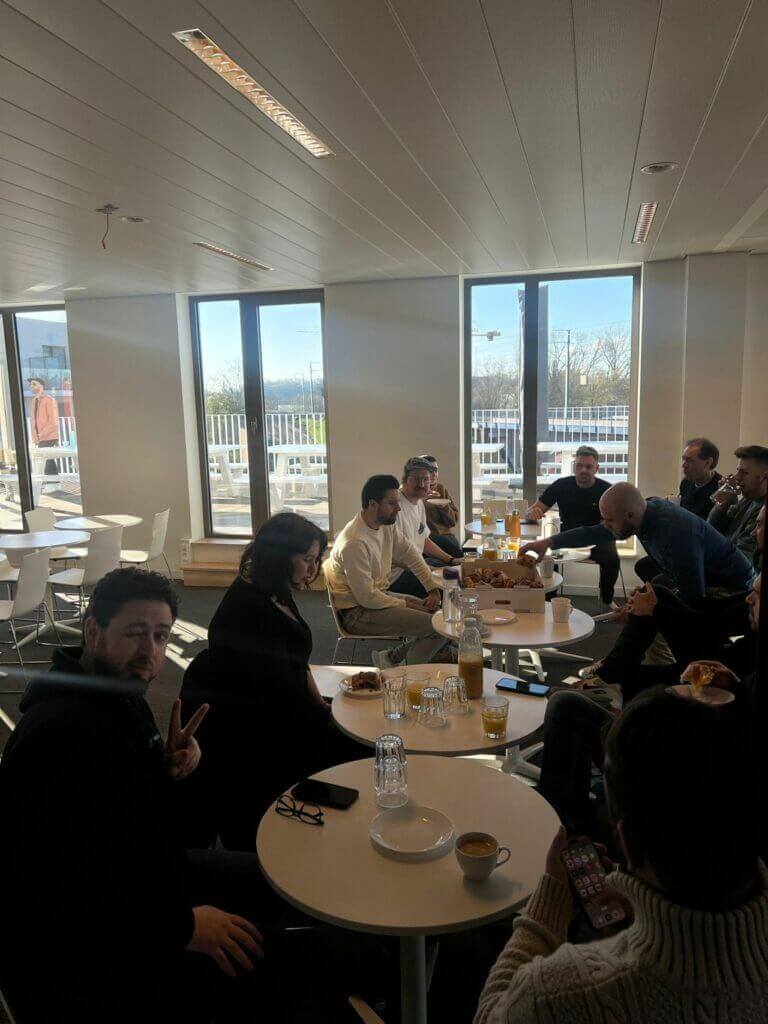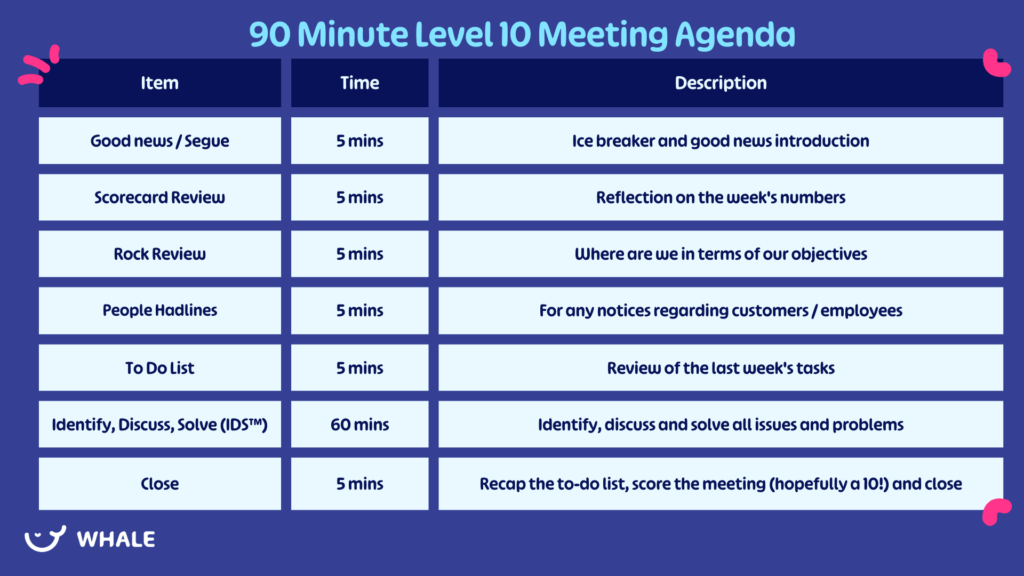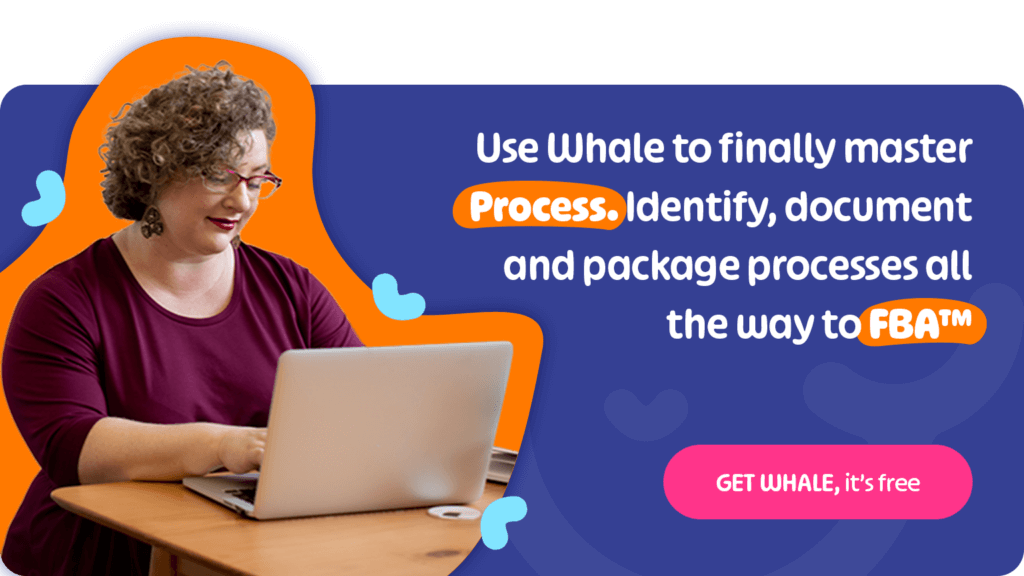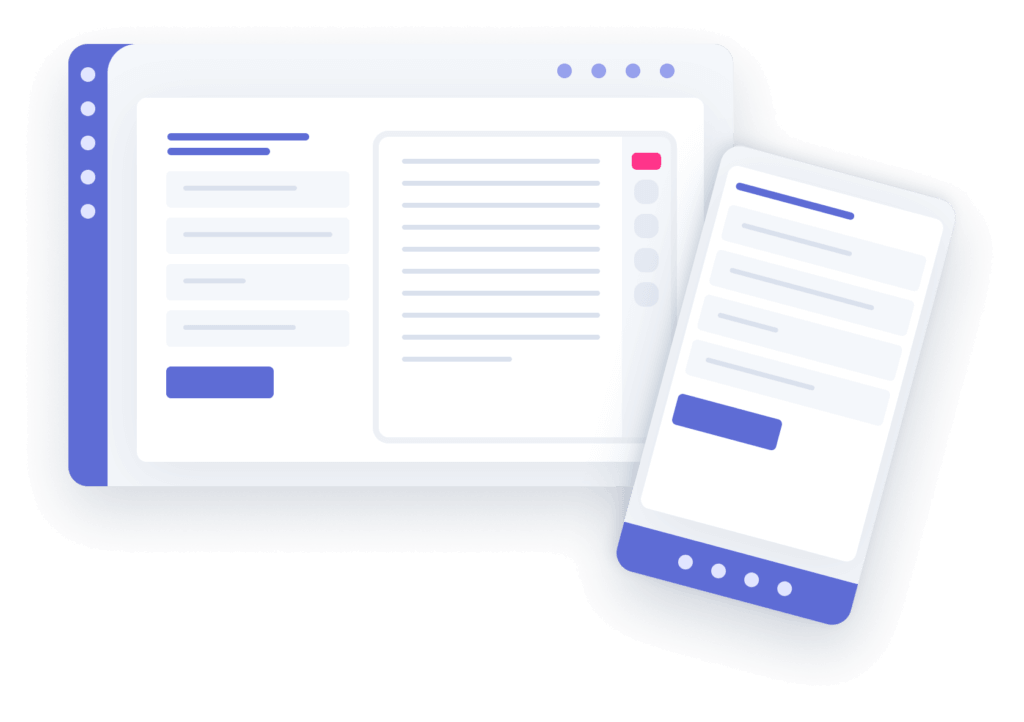Did you know that, on average, employees attend 62 meetings per month? And that they view half of those meetings as a total waste of their time?
Enter the Level 10 Meeting™ as trademarked and conceptualized by EOS®.
The Level 10 Meeting is a process-driven approach to making your meetings way more productive.
Instead of spending half of your time in meetings talking about the weekend, giving status updates, or digging into the background of every little mishap. The Level 10 Meeting agenda nixes the chit-chat and focuses only on the things that are going to move the needle on your mission, namely:
- Understanding the BIG issues in your business
- Solving them
It’s simple, logical, and achievable with some hard work. But you have to stick to the process.
What exactly is an Level 10 Meeting?
A Level 10 Meeting is a weekly meeting that lasts for about 90 minutes, and it’s designed to help you and your team stay focused on your goals and priorities. Think of it like a power-up session for your productivity levels.
Now, we know what you’re thinking. "A 90-minute meeting? That sounds like torture!" But trust us, it’s worth it. The Level 10 Meeting is structured in such a way that it keeps everyone engaged and on-task, and it helps you get to the heart of the matter quickly.
We use it to keep our team at Whale and we recommend that you do too!
How the Level 10 Meeting began
Level 10 Meetings are part of the EOS (Entrepreneurial Operating System) toolkit.
The founder of EOS Worldwide, Gino Wickman knows the devastating impact of inefficient meetings can have on revenue. So when he created the Entrepreneurial Operating System®, he made sure that an element focused on meetings.
What do you need a Level 10 Meeting?
Well, for starters, it ensures that everyone on your team is aligned and working towards the same objectives. It also helps you identify and solve issues faster, so you can stay on track and avoid getting derailed by unexpected problems.
Plus, because the Level 10 Meeting is structured and focused, it’s a great way to stay accountable and ensure that everyone is on top of their tasks and responsibilities. And let’s be real – who doesn’t love a good dose of accountability?
Ultimately the Level 10 Meeting is like a superhero team-up for your business, and who doesn’t want to be a superhero?
What are the 5 rules for an effective Level 10 Meeting?
If your meetings are going to come close to achieving that perfect 90-minute Level 10 Meeting, you need to prioritize these five factors every week:
- Same day
- Same time
- Same agenda
- Starts on time
- Ends on time
- Meet on the same day each week
The most important factor is to meet on the same day each week.
At Whale 🐳 , we start our Mondays with our Level 10 Meetings, making sure we’re ready for UBER productivity for the week!
When a new team member starts, we occasionally host a breakfast BEFORE we start but we keep our meetings on the same day each week and same time. No excuses!

2. And meet at the same time each week
But one of the first rules of a successful Level 10 Meeting is to stick to a set meeting time and not cave to anyone else’s busy schedule. The moment you do, your meeting loses its importance and becomes something your team will think they can bail on whenever they have something else to do that feels more important.
At Whale 🐳 , you’ll find that Monday mornings are Level 10 Meetings. 10am for marketing, 11am for product and so we go!
3. Start on time each week
At Whale 🐳 , we have a rule. If you’re on time, you’re late, and five minutes early is on time.
Timing is SUPER important if you’re going to crack your meetings.
4. End on time each week
You have to respect people’s time. And the only way to do that is to have the discipline to stick to your timings.
Setting out your expectations and intentions is essential here. For example, if your first Level 10 Meeting starts late and runs over by 30 minutes, that’s what your attendees will remember.
At Whale 🐳 we HAVE to end our meetings on time in order to start the next one on time.
5. Stick to the same agenda
The whole purpose of the Level 10 Meeting is to keep you on task, focused on the big issues, and pressing forward towards that vision.
It may be tempting, but the agenda is there for a reason — stick to it.
Good questions, let’s check ’em out.

At Whale 🐳, in accordance with the general Level 10 Meeting structure, we have check-in followed by our scorecard, followed by our rocks, and then onto headlines, to-dos and issues. Then it’s time to close to action that to-do list!
Sticking to the same agenda each week makes each meeting UBER productive!
What is the Level 10 Meeting agenda?

There are 7 parts to a Level 10 Meeting agenda.
Sometimes that’s a tough ask, especially when a lot is going on or a major week in the office.
It can be tempting to add a little extra time to an agenda item or over-index on one section. But remember: the sole purpose of a Level 10 Meeting is to understand the top issues stopping your company from reaching its vision.
Anything else is just noise.
Some weeks you may be able to cover ten issues. Others, it may only be three.
But as long as you’ve prioritized your issues, understood them, and solved them — that’s progress.
So, 90 minutes on the clock — let’s meet!
- Check in – 5 minutes
This is where everyone in the meeting takes turns sharing a personal and professional update. It’s a great way to build team cohesion and get everyone on the same page.
Since 2019, we’ve been bombarded with bad news. 91% of the news we’ve been reading is likely negative.
Start your Level 10 Meeting off on the right foot by sharing:
- A point of personal good news
- Some professional good news
Why?
Because with personal news, you’re allowing humanity into your meeting, and you’re getting to know and trust your team.
2. KPI Checkin – 5 minutes
This is where you review your key metrics and data points to see how you’re tracking towards your goals. It’s like a progress report, but way more exciting.
Every company has KPIs, OKRs, MBOs, KRAs. The basic principle is the same, whichever oh-so-catchy acronym you decide to go with.
You have something you want to achieve, milestones to get there, and a way to track and measure your progress.
Whether you’re on target to achieve your vision comes down to data and metrics. And your Level 10 Meeting is an excellent way of keeping everybody who needs to know in the know.
But you gotta be quick about it, so make sure you have your numbers ready beforehand and comment on insights rather than just the numbers.
3. Rock review – 5 minutes
Remember those SMART rocks? Well this is the time to review them.
Rocks are the 3 -7 most important goals for every quarter.
By sticking as close to three per quarter as possible, you’re increasing your focus and, with it, the likelihood you’ll achieve your Rocks.
4. People Headlines
This one’s pretty simple. If there are any major customer or employee call-outs, good or bad, now’s the time to mention them.
5. The Level 10 Meeting to-do List – 5 minutes
Your to-do list is the main constant between your meetings each week. It also adds the accountability factor, so it’s pretty crucial in achieving the growth you’re after.
After each meeting, your attendees have seven days to go away and complete their action items. So please make sure they’re SMART, incentivized, and prioritized, so the important ones are always tackled first and executed by the next meeting.
6. The issues at hand list 🕵️ – 60 minutes
Eat your issues for breakfast!
By focusing on issues, you’ll find that problem-solving becomes a way of life!
60 minutes seems like a lot but it can fly by if you’re not conscious and focused on solving the issues at hand.
But by adopting a growth mindset, you’re sure to turn every issue into an opportunity.
This mindset allows individuals to approach problem-solving with a sense of curiosity, openness, and flexibility and to be willing to try new approaches and strategies.
By contrast, a fixed mindset, where individuals believe that their abilities and intelligence are fixed and cannot be changed, can hinder problem-solving skills. This mindset can lead to a fear of failure and a tendency to give up quickly when faced with challenges or obstacles.
Having a growth mindset helps individuals stay motivated and focused on finding solutions, even when the path forward is not immediately clear.
At Whale 🐳 we we discuss issues in our meetings, we state the issue, give context and give ideas to solve the problem before discussing each issue with the rest of the team.
7. Wrap up – 5 minutes ⏰
With 5 minutes remaining, it’s important to sign off by:
- Recapping the to-do list.
- Planning how to filter the meetings points down to the rest of the organization.
- Rating the meeting between 1 – 10 (10 being the best).
Ding ding!
And congrats! That’s a wrap!
By now, you’ll have achieved so much more than any half-day conference or hefty email chain. And with a few core processes penned down, you’ll be ready to remove the bottlenecks from your business and watch that revenue soar even further.
The key to ultimate Level 10 Meeting productivity: Process🚀
At Whale, we’re ALL about process! If you don’t have a process it isn’t repeatable and it can’t be a lever in your business.
So there’s one final thing to think about before you send out those Level 10 Meeting invites: the processes you’ll need to succeed.
By identifying and documenting your Level 10 Meetings processes, you have the opportunity to use your SOPs to boost your ROI tangibly.
Do it right, and each department, team, and project group can host their uber-efficient Level 10 Meeting — cutting the problem-solving time down at every level and maximizing your resources and shared knowledge across the business.
Ready to document your Level 10 Meeting SOPs? Start here:
- Sending the invite: What’s the process for selecting a time, date, attendees, venue, equipment, roles, etc.?
- How to write an uplifting segue: As a company, what’s the process for deciding what to share here and how to share it?
- Consider your scorecard metrics: What process should employees go through to choose the metrics to focus on?
- Decide your Rocks by asking: What is the process for determining quarterly Rocks?
- Writing the to-do list: What format should it take? Where is it stored? Who owns it?
- How to IDS® to impress: What format should your issues conversation take? What is the process for dealing with debate? Where should notes be stored?
- Sharing: What is the process for cascading a meeting summary to the organization?
- Meeting rating: What is the process for rating a meeting?
- The what-ifs: What if an attendee can’t come? What if your score is below 8? What if you repeatedly go over time? What processes do you have in place?
The right processes, documented in the right place, and easily accessible to all means your Level 10 Meetings can be easily scaled company-wide.
FAQs about the Level 10 Meeting
Why is it called a Level 10 (L10) meeting?
The term "L10" in the context of a Level 10 Meeting refers to a specific format and structure of meetings that are part of the Entrepreneurial Operating System (EOS). EOS is a set of concepts and tools designed to help entrepreneurs and business leaders get what they want from their businesses by creating clarity, generating real traction, and fostering a healthy team culture.
A Level 10 Meeting, as prescribed by EOS, is structured to ensure maximum efficiency and effectiveness, allowing teams to address issues head-on, track progress, and stay aligned with the company’s core goals. The "10" in L10 stands for the goal of making the meeting so productive and engaging that participants would rate it a 10 on a scale of 1 to 10.
How do I prepare for a L10 meeting?
Preparing effectively for a Level 10 Meeting within the Entrepreneurial Operating System (EOS) framework is essential to maximize its benefits. Here are some key steps to ensure you are well-prepared:
Set Personal and Professional Good News
- Reflect on any positive developments or achievements, both in your personal life and professionally, that you can share during the Segue section of the meeting.
2. Review Previous Action Items
- Start by reviewing the action items assigned to you from the last meeting. Ensure that you have made significant progress or completed them. Be ready to update the team on your progress or explain any delays.
3. Gather and Analyze Data for the Scorecard
- Collect all relevant data and metrics that you are responsible for reporting on the scorecard. Analyze the data for trends or issues that may need to be addressed during the meeting.
4. Update Your Rocks
- Review the progress of your quarterly priorities or "Rocks". Be prepared to discuss any obstacles you’re facing and consider if you need support from the team to overcome them.
5. Compile Customer and Employee Headlines
- If you have any significant news about customers or employees, gather the details. This could include positive feedback, a major complaint, a significant achievement, or an issue that needs to be addressed.
6. Identify and Prioritize Issues
- Think about any issues you’ve encountered since the last meeting that need to be discussed. Use the EOS "IDS" (Identify, Discuss, Solve) process to start thinking about these issues critically. Prioritize the issues you believe are most important to address.
7. Prepare Your Mindset
- A positive and constructive attitude is crucial. Consider any feedback or difficult conversations you may need to have and approach them with a solution-focused mindset.
8. Gather Necessary Documents or Reports
- Prepare any documents, reports, or presentations you need to share during the meeting. Ensure they are clear and concise to facilitate effective discussion.
9. Think About Your Contributions to Conclude
- Consider what messages, if any, you need to cascade to your team or department after the meeting. Also, think about how you will rate the meeting and any feedback you might have to make it more effective.
By thoroughly preparing for a Level 10 Meeting, you contribute to its effectiveness and ensure that the time spent is productive.
Bottom line?
When was the last time you had a really effective meeting? One that produced outcomes and really shifted the needle?
If the answer is you can’t remember, you may need a Level 10 meeting!
The bottom line is that Level 10 meetings are structured impactful, and action-oriented. They ensure;
- the right decision makers are in the room
- impactful decisions get made
- and that there’s accountability across the board!
Holding a world-class meeting is a skill. It’s all about holding a meeting that scores a 10, every time!
The time that you spend in a level 10 meeting will help you avoid problems before they even arise and make you ultra productive!
Get documenting & training NOW
What is your greatest challenge?
SOP & Process Documentation
Use Whale to create SOP & Process Documentation and centralize everything in an easily accessible single source of truth.
Employee Onboarding & Training
Whale is the fastest way to get your team aligned. Discover how Whale boosts team performance and ensures new hires excel from the get-go.
Companies on EOS ®
Whale is the all-in-one system for teams running on EOS® to help document your processes, train your teams, and build a foundation for growth.











